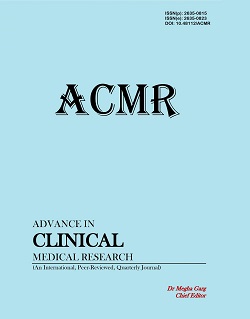Outcome of Total Laparoscopic Hysterectomy in Obese Patients
Outcome of Total Laparoscopic Hysterectomy in Obese Patients
Keywords:
Outcome, Total Laparoscopic Hysterectomy, Obese Patients, Non-obese Patients, BMIAbstract
 Abstract Views: 156
Abstract Views: 156
Introduction: Globally, obesity is a major health issue that has an impact on many facets of patient care and surgical results. Morbid obesity traditionally considered to be a contra indication to total laparoscopic hysterectomy is now evolving into an indication. Innovations and advancement in minimally intrusive. Surgical techniques have significantly improved patient morbidity and mortality rates, reduced operational costs and overall suffer surgical experience. Objective: The purpose of this study was to assess the risk of operative and post-operative complications of obese patients undergoing total laparoscopic hystertomy compared with non-obese patients. Materials and Methods: The cross-sectional observational study was conducted in the Department of Obstetrics and gynaecology, Labaid Specialized Hospital, Dhaka from January 2022 to December 2022. A total of 90 patients who underwent TLH. The patients were divided into 2 groups based on BMI, BMI < 30 kg/m2 (n=52) and BMI ≥ 30 kg/m2 (n=38). The questionnaire was pretested, corrected and finalized. Data were collected by face-to-face interview and analyzed by appropriate computer based programmed software Statistical Package for the Social Sciences (SPSS), version 24. Results: Mean age of the study subjects was 41.5±1.3 and 43.3±2.3 years in non-obese and obese group respectively. Mean BMI of the study subjects was 29.1±2.5 and 32.1±3.1 kg/m2 in non-obese and obese group respectively. The mean length of postoperative hospital stay for all subjects was 1.1 days. The mean length of stay among obese patients was 1 day compared with 1.2 days for nonobese patients. Only 6 (6.7%) study women were readmitted for postoperative complications, of whom 2 (5.3%) were obese. 5 (5.5%) patients required reoperation. Two (5.3%) of these patients were obese. Ten (11.1%) patients experienced major complications, 3 (7.8%) of which occurred in the obese group. Seven (7.8%) patients experienced minor complications, 2 (5.3%) of which occurred in the obese group. Conclusion: The majority of obese people can have a total laparoscopic hysterectomy with success, and the rate of complications is comparable to that of nonobese patients.
References
Finkelstein EA, Khavjou OA, Thompson H, et al. Obesity and severe obesity forecasts through 2030. Am J Prev Med 2012; 42: 563-570.
Organization WH. Overweight and obesity [Available from: http://www.who.int/gho/ncd/risk_factors/overweight_obesity/obesity_adults/en/.
Louie M, Toubia T, Schiff LD. Considerations for minimally invasive gynecologic surgery in obese patients. Curr Opin Obstet Gynecol 2016; 28: 283-289.
Chiofalo B, Laganà AS, Palmara V, et al. Fasting as possible complementary approach for polycystic ovary syndrome: Hope or hype? Medical hypotheses 2017; 105: 1-3.
Onstad MA, Schmandt RE, Lu KH. Addressing the Role of Obesity in Endometrial Cancer Risk, Prevention, and Treatment. J Clin Oncol 2016; 34: 4225-4230.
Laganà AS, Vitale SG, Nigro A, et al. Pleiotropic Actions of Peroxisome Proliferator-Activated Receptors (PPARs) in Dysregulated Metabolic Homeostasis, Inflammation and Cancer: Current Evidence and Future Perspectives. International journal of molecular sciences 2016; 17.
Vitale SG, Capriglione S, Zito G, et al. Management of endometrial, ovarian and cervical cancer in the elderly: current approach to a challenging condition. Archives of gynecology and obstetrics 2019; 299: 299-315.
Huls CK. Cesarean Hysterectomy and Uterine-Preserving Alternatives. Obstet Gynecol Clin North Am 2016; 43: 517-538.
Rossetti D, Vitale SG, Bogani G, Rapisarda AM, Gulino FA, Frigerio L. Usefulness of vessel-sealing devices for peripartum hysterectomy: a retrospective cohort study. Updates in surgery 2015; 67: 301-304.
Wang HL, Ren YF, Yang J, Qin RY, Zhai KH. Total laparoscopic hysterectomy versus total abdominal hysterectomy for endometrial cancer: a meta-analysis. Asian Pac J Cancer Prev 2013; 14: 2515-2519.
Casarin J, Multinu F, Ubl DS, et al. Adoption of Minimally Invasive Surgery and Decrease in Surgical Morbidity for Endometrial Cancer Treatment in the United States. Obstet Gynecol 2018; 131: 304-311.
Kiyak H, Karaaslan O, Seckin KD, et al. Preoperative Factors Associated with the Need for the Morcellation in Total Laparoscopic Hysterectomy. Eastern Journal of Medicine 2020; 25: 260-266.
Aarts JW, Nieboer TE, Johnson N, et al. Surgical approach to hysterectomy for benign gynaecological disease. Cochrane Database Syst Rev 2015: CD003677.
Mikhail E, Miladinovic B, Velanovich V, Finan MA, Hart S, Imudia AN. Association between obesity and the trends of routes of hysterectomy performed for benign indications. Obstet Gynecol 2015; 125: 912-918.
Committee on Gynecologic Practice. Committee opinion no. 619: Gynecologic surgery in the obese woman. Obstet Gynecol 2015;125(1):274–278.
Unger SW, Scott JS, Unger HM, Edelman DS. Laparoscopic approach to gallstones in the morbidly obese patient. Surg Endosc 1991;5:116 –7.
Miles RH, Carballo RE, Prinz RA, McMahon M, Pulawski G, Olen RN, et al. Laparoscopy: the preferred method of cholecystectomy in the morbidly obese. Surgery 1992;112:818 –23.
chrimer BD, Dix J, Edge SB, Hyser MJ, Hanks JB, Aguilar M. Laparoscopic cholecystectomy in the obese patient. Ann Surg 1992;216:146 –52.
Mendoza D, Newman RC, Albala D, Cohen MS, Tewari A, Lingeman J, et al. Laparoscopic complications in markedly obese urologic patients (a multi-institutional review). Urology 1996;48:562– 67.
Holub Z, Jabor A. Kliment L, Fischlova D, Wagnerova M. Laparoscopic hysterectomy in obese women: a clinical prospective study. Eur J Obstet Gynecol Reprod Biol 2001;98:77– 82.
Milad MP, Morrison K, Sokol A, Miller D, Kirkpatrick L. A comparison of laparoscopic supracervical hysterectomy vs laparoscopically assisted vaginal hysterectomy. Surg Endosc 2001;15:286–88.
Ostrzenski A. Laparoscopic total abdominal hysterectomy in morbidly obese women: a pilot-phase report. J Reprod Med 1999;44:853– 8.
O’Hanlan KA, Lopez L, Dibble SL, Garnier A, Shining Huang G, Leuchtenberger M. Total laparoscopic hysterectomy: body mass index and outcomes. Obstet Gynecol 2003;102:1384 –92.
Holtz G. Laparoscopy in the massively obese female. Obstet Gynecol 1987;69:423– 4.
Halpern NB. Access problems in laparoscopic cholecystectomy: postoperative adhesions, obesity, and liver disorders. Semin Laparosc Surg 1998;5:92–106.
Loffer FD, Pent D. Laparoscopy in the obese patient. Am J Obstet Gynecol 1976;125:104 –7.
Sokol AI, Chuang K, Milad MP. Risk factors for conversion to laparotomy during gynecologic laparoscopy. J Am Assoc Gynecol Laparosc 2003;10:469 –73.
Eltabbakh GH, Piver MS, Hempling RE, Recio FO. Laparoscopic surgery in obese women. Obstet Gynecol 1999;94:704–08.
Matory WE Jr, O’Sullivan J, Fudem G, Dunn R. Abdominal surgery in patients with severe morbid obesity. Plast Reconstr Surg 1994;94:976–87.
Olsson JH, Ellstrom M, Hahlin M. A randomised prospective trial comparing laparoscopic and abdominal hysterectomy. Br J Obstet Gynaecol 1996;103:345–50.
Ellstrom M, Ferraz-Nunez J, Hahlin M, Olsson JH. A randomized trial with a cost-consequence analysis after laparoscopic and abdominal hysterectomy. Obstet Gynecol 1998;91:30 –34.
Wattiez A, Soriano D, Cohen SB, Nervo P, Canis M, Botchorishvili R, et al. The learning curve of total laparoscopic hysterectomy: comparative analysis of 1,647 cases. J Am Assoc Gynecol Laparosc 2002;9:339–45.




 OAI-PMH
OAI-PMH 